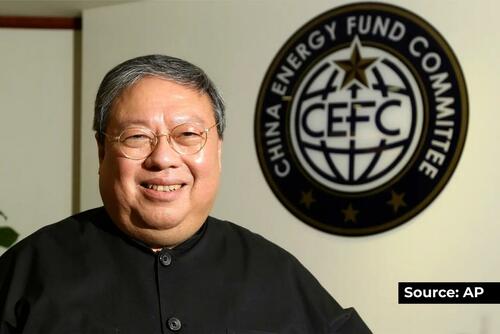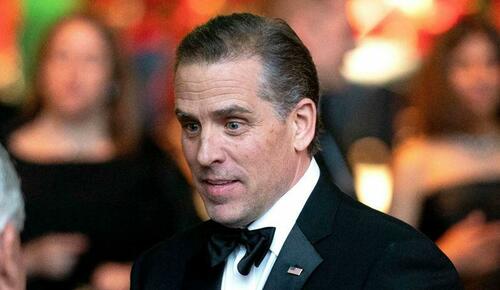First brother Jim Biden told Congress last week that Hunter Biden held a previously undisclosed meeting with Patrick Ho, an executive with Chinese energy conglomerate CEFC China Energy - which, weeks earlier, paid Hunter and Jim Biden $5 million as part of a joint venture to find investments for the Chinese firm, the Washington Free Beacon reports.
Hunter had previously referred to Ho as "the fucking spy chief of China" in an audio recording dated May 11, 2018.
In a congressional deposition last month, Jim Biden said he accompanied Hunter Biden to Hong Kong in September 2017 to meet with Patrick Ho...
...The Biden family’s arrangement with CEFC China Energy has stoked national security concerns because of the Chinese firm’s links to Chinese military intelligence. Middlemen for CEFC China Energy approached Hunter Biden in 2015, when his father was vice president, about potential business deals.
According to Jim Biden, he and Hunter Biden had a "pleasant" lunch in Hong Kong with Ho, who also served as head of the China Energy Fund Committee, a think tank funded by CEFC China Energy. At the end of the meeting, Ho asked to meet alone with Hunter Biden, according to Uncle Jim. -Washington Free Beacon
According to Jim Biden, "Ho said, ‘Can I borrow Hunter for, you know, a half-hour? We're going to go in the next room.’"
CEFC paid Hunter $1 million to represent Ho, however Hunter does not appear to have done any actual legal work on Ho's behalf. According to court records, the US government was surveilling Ho under a FISA warrant because they suspected that he was a possible agent of a foreign government.
Worming their way in
Jim Biden also described how CEFC entered the Biden orbit - telling congressional investigators that the father of one of Hunter's daughter's classmates contacted Biden about working with CEFC. The man, Scott Oh, gave Hunter a diamond ring after approaching Hunter in October 2015 to discuss "investment opportunities" involving CEFC.
Meanwhile, a former Hunter Biden business associate has revealed in a jailhouse confession that the first son sought roughly $5 million from fugitive Ukrainian oligarch Dmitri Firtash in order to try and quash a US indictment while his father Joe Biden was Vice President, Just the News reports.
Jason Galanis’ jailhouse account of an effort to assist Firtash was recently provided to the House Oversight and Judiciary Committees in President Joe Biden’s impeachment inquiry, and it corroborates a story from Just the News in 2021 in which Firtash’s longtime righthand man Hares Youssef confirmed the future first son was engaged in 2015 to try to help solve Firtash’s legal woes in the United States.
Both Hares in 2021 and Galanis last month said Hunter Biden was unsuccessful – Firtash still faces charges and is fighting extradition to the United States from his safe harbor in Austria – but the efforts ultimately resulted in a $3 million investment in a tech fund called mBloom that Galanis and other Hunter Biden partners had formed.
According to the report, around $300,000 of the $3 million made it into Rosemont Seneca Bohai, one of Hunter Biden's firms - which was also used for payments Hunter received from a second Ukrainian oligarch, Mykola Zlochevsky - president of Burisma Holdings energy firm.
As Just the News reports further, Gelanis told Congressional impeachment investigators:
- Hunter Biden offered to help Firtash try to “influence or attempt to quash” his federal indictment;
- Galanis believed either $5 million or $5.5 million was delivered to Boies, where Hunter worked as a lawyer. The payment was to compensate Hunter Biden for trying to resolve Firtash's U.S. legal issues;
- Youseff became “very unhappy” with Hunter Biden’s work on the matter because of the lack of progress resolving Firtash's criminal case;
- Eventually, the effort ended and Youseff arranged to transfer $3 million of Firtash’s money to a tech startup associated with Galanis and other Hunter Biden business partners called mBloom.
- mBloom then sent about $300,000 of that money to Rosemont Seneca Bohai, a firm where Hunter Biden often got paid for his Burisma work.
Firtash was indicted in 2014 by the Obama-Biden DOJ on allegations of corruption, and has been represented by several powerful American lawyers, including former Clinton White House lawyer Lanny Davis, ex-U.S. Attorney Dan Webb and former DOJ officials Joseph diGenova and Victoria Toensing.
In court, his lawyers have argued that the charges filed in Chicago were unwarranted.
"He didn't pay any bribes. He's not even charged with paying bribes. He's charged with a scheme to bribe, involving a transaction in India, that never happened," Lanny Davis said back in 2021.
According to Hunter's own recent testimony to Congress, Firtash was believed to be aligned with Vladimir Putin.
"There were two gas companies inside of Ukraine at that time. One of them was the state-owned, which was highly corrupt and connected to people like Firtash, which was directly going into Vladimir Putin's pocket," he said, explaining that Firtash's ties to Russia were connected to why he joined the board of Burisma.
"The only independent company was Burisma. And Burisma was supplying 60 percent of all natural gas to power the entire industry in Ukraine, including 78 percent of all steel mills. And so they needed to survive."

